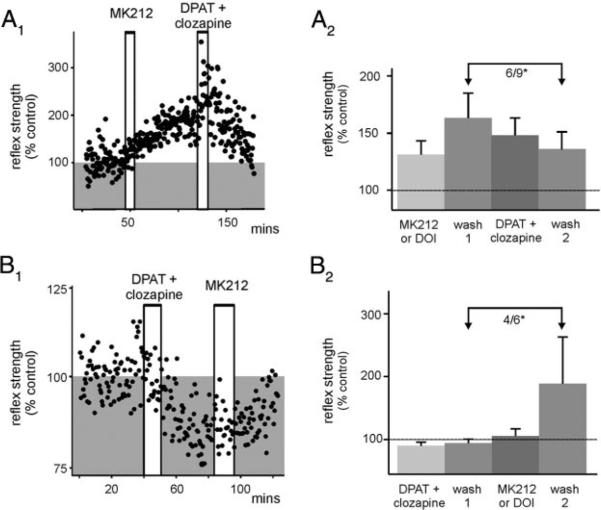FIG. 6.
5-HT1 receptor activation can induce a long-lasting reflex depression (LLDR) and can reverse LLFR. A1: Scatterplot showing that MK212-induced LLFR can be reversed after selective 5-HT1A receptor activation for 10-30 min (DPAT + clozapine). A2: effect of 5-HT2 receptor activation (MK212 or DOI) then 5-HT1 receptor activation (DPAT and clozapine) normalized to predrug control reflex amplitude. 5-HT1 receptor activation reversed the 5-HT2 receptor induced LLFR in 6/9 cases (P < 0.05). This is shown with arrows comparing reflex amplitude after MK212 or DOI washout to reflex amplitude after DPAT and clozapine washout. Stimuli were delivered at 500 μA, 500 μs, 0.03 Hz and in one case 500 μA, 100 μs, 0.03 Hz. B1: scatterplot example showing that after selective activation of 5-HT1A receptors [8-hydroxy-2-(dipropylamino)-tetralin (8-OH-DPAT; 5-HT1A/7 agonist) and clozapine (5-HT7 antagonist)], LLDR is observed which can be reversed after MK212 application. B2: effect of DPAT + clozapine on reflex normalized to control (LLDR in 4/6, P < 0.05), then after application of DOI (or MK212), normalized to wash 1 (6/6 reversed but LLFR in 4/6, P < 0.05). This is shown with arrows comparing reflex amplitude after DPAT and clozapine washout to reflex amplitude after MK212 or DOI washout. Stimuli were delivered at 500 μA, 500 μs, 0.03 Hz; and in one case 100 μA, 100 μs, 0.03 Hz.

